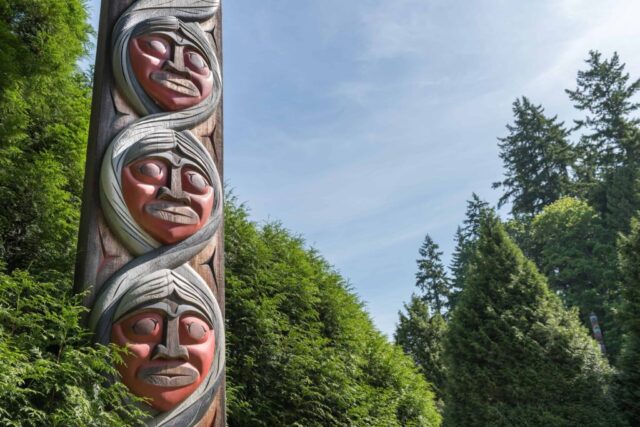The City of Vancouver is located on the unceded, ancestral and traditional territory of the xʷməθkʷəy̓əm (Musqueam), Sḵwx̱wú7mesh (Squamish) and səlil̓wətaʔɬ (Tsleil-Waututh) peoples. Indigenous communities have lived here since time immemorial and have a long-established history of settlement, stewardship of the land and harvesting of resources.
Many of the following resources have been created by local Indigenous communities and include interactive maps, videos and teaching materials. They are shared here as a starting point for learning about the history and cultural heritage of the communities, including heritage places, and are only a selection of the many resources available.
Indigenous cultural heritage has often not been well-represented to date in formal recognitions of heritage places and history in Vancouver, such as the Vancouver Heritage Register. We encourage you to explore the resources below to begin to learn about local heritage places and cultural heritage of Indigenous communities in Vancouver.
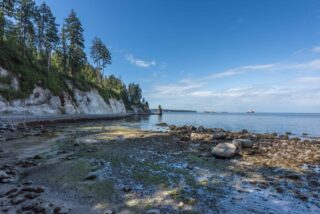
Local First Nations
British Columbia is home to 204 First Nations communities and an amazing diversity of Indigenous languages. Learn more about these communities with the First Peoples’ Map of B.C. An educational resource created by the First Peoples’ Cultural Council, it is intended for both Indigenous and non-Indigenous people to learn about and explore the history of First Nations culture using this interactive map highlighting Indigenous arts, language and culture throughout the province. If you would like to know more about Indigenous place names across Canada, visit Stories from the Land.
The land that is now known as the City of Vancouver is home to many Indigenous peoples and is the traditional territory of three nations – the xʷməθkʷəy̓əm (Musqueam), Sḵwx̱wú7mesh (Squamish) and səlil̓wətaʔɬ (Tsleil-Waututh) peoples. For guidance on how to correctly pronounce local place names and identify some key resources found in the Vancouver area in the languages spoken by the Musqueam, Squamish and Tsleil-Waututh Nations: hən̓q̓əmin̓əḿ and Sḵwx̱wú7mesh Sníchim, visit Where We Are On Unceded Lands.
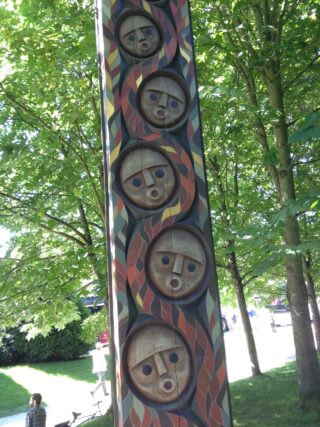
xʷməθkʷəy̓əm (Musqueam)
- Musqueam – Our Story
- Musqueam Place Names Map with audio files to hear Musqueam place names in hən̓q̓əmin̓əm̓
- The Origin of the Name Musqueam video
- Musqueam: Giving information about our teachings includes videos, interactive language stories and timeline video.
Sḵwx̱wú7mesh (Squamish)
- Squamish Nation – Our History
- Squamish Atlas Map , created by Kwi Awt Stelmexw, shows places used, occupied, visited, or known about by past and present Sḵwx̱wú7mesh language-speakers
səlil̓wətaʔɬ (Tsleil-Waututh)
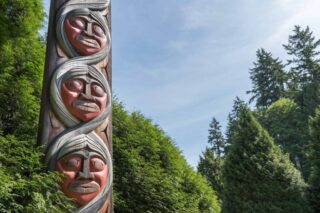
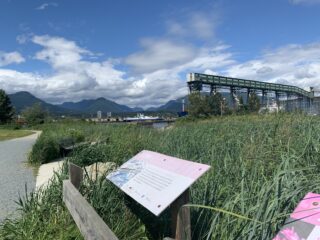
Places That Matter
VHF and Musqueam have offered a variety of public programs related to the Places That Matter project. A pilot Musqueam Bus Tour of Vancouver in 2013 offered three tours with stops around the city at the Musqueam Reserve, UBC, Stanley Park and Spanish Banks. VHF continues to collaborate with the Musqueam Archives and Musqueam Department of Language and Culture.
Over the course of five years, members of the Musqueam community selected five sites that were marked with Places That Matter plaques. The five sites are listed below along with two additional sites that have connections to local Indigenous history. We are continuing to develop the Places That Matter pages and we are continuously adding additional sites in collaboration with various communities. Please contact VHF or follow us on social media for more information and updates on the project.
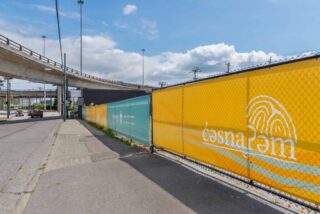
c̓əsnaʔəm (Marpole along the Fraser River)
“c̓əsnaʔəm, one of our Musqueam villages, existed on the stal̕əw̓ (now called the Fraser River) long before Vancouver was founded… Today, c̓əsnaʔəm has been paved over and built upon, yet it remains part of our territory, culture, and history.”
This history is told by Musqueam First Nation.
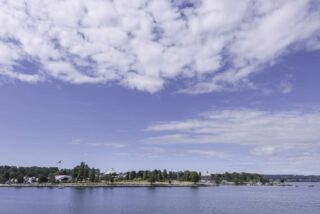
səna̓ ʔqʷ (Vanier Park, Kitsilano)
The area now known as Burrard Inlet is host to numerous Musqueam villages, camps, and transformer sites. It was connected by water ways, trails, histories, and genealogies to other villages throughout our territory. For example, trails radiated from sən̓aʔqʷ across ʔəlqsən (Point Grey) to our villages of c̓əsnaʔəm and xʷməθkʷəy̓əm on the North Arm of the stal̕əw̓ (now called the Fraser River).
The history of this place is told by the Musqueam First Nation.
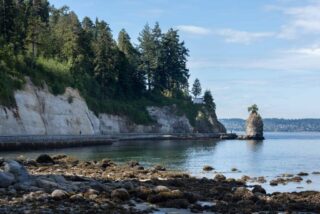
sɬχil̕əx (Siwash Rock, Stanley Park)
Our territory is marked by sites where powerful beings, χe:l̕s, the transformers, visited on their travels. They transformed people into animals or aspects of the landscape. sɬχil̕əx (standing) is an important transformation site where χe:l̕s transformed a man to stone for his conduct and, like other transformer sites, reminds us of our teachings and the interconnectedness of our territory.
The history of this place is told by the Musqueam First Nation.
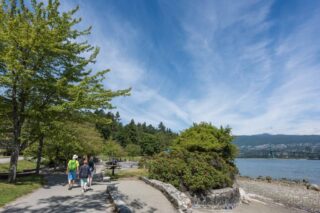
χʷay̓χʷəy ̓ (Lumberman’s Arch, Stanley Park)
χʷay̓χʷəy̓ was once a large Musqueam village, with several longhouses, and home to hundreds of our ancestors at a time. χʷay̓χʷəy̓ is also an important spiritual site to our people. It’s from this village our ancestors received the sχʷay̓χʷəy̓ mask and teachings; a culturally sensitive hereditary cleansing right.
The history of this place is told by the Musqueam First Nation.
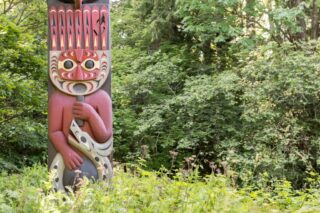
spapəy̓əq (Brockton Point, Stanley Park)
The area now known as Stanley Park is host to numerous important villages, transformer, and resource sites. spapəy̓əq (bent at the end) was home to Musqueam families into the early 1900s. Rose Yelton (nee Cole), Daughter of Matilda Cole (nee Pete) of Musqueam, was among the last to live in Stanley Park.
The history of this place is told by the Musqueam First Nation.
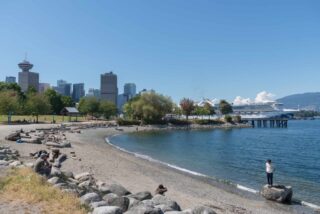
CRAB Park (site of the Great Fire and Squamish history)
On June 13, 1886, the newly incorporated city of Vancouver burned to the ground in less than thirty minutes, and Squamish first responders were essential to the rescue efforts, which the City of Vancouver formally acknowledged in 2017. Today, an area once ravaged by the Great Fire is home to CRAB Park, which was tirelessly fought for by a community group.
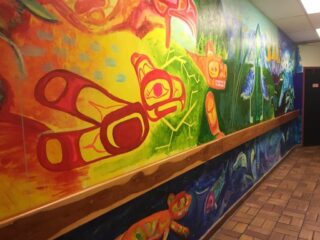
Vancouver Aboriginal Friendship Centre
“Since 1963, the Vancouver Aboriginal Friendship Centre Society has been meeting the needs of aboriginal people making a transition to the urban Vancouver community.” – Vancouver Aboriginal Friendship Centre
Vancouver’s Aboriginal Friendship Centre was the second centre (after Toronto) to open in Canada, and today Friendship Centres in the Greater Vancouver Regional District serve a clientele of over 40,000 urban indigenous people. There are programs and services in health, welfare, human rights, culture, education and recreation for Indigenous people of all ages.
Decolonizing Heritage
The video below was a virtual Heritage Lunch and Learn session hosted by VHF where speakers offer in-depth illustrated talks followed by a Q&A. These lunchtime talks bring together heritage professionals and enthusiasts alike to learn about the state of heritage and conservation projects in Vancouver today with experts in architecture and design, conservation, city planning and other related fields. The talks discuss issues, local projects and topics that are relevant to the future of Vancouver’s historic neighbourhoods, buildings and landscapes.
Expanding Relevance through Decolonizing Heritage
Rena Soutar, Manager of Decolonization, Arts & Culture at the Vancouver Park Board and Julia Hulbert, Arts & Culture Planner at the Vancouver Park Board led a conversation on the expanding relevance of heritage. This lunch-time conversation introduced how the field of heritage planning can begin to decolonize and reckon with difficult histories.
National Day for Truth and Reconciliation
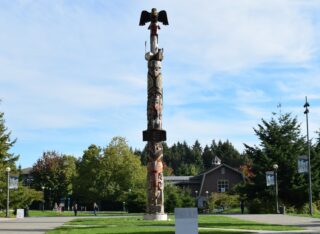
Since 2013, September 30 has been known as Orange Shirt Day – grassroots campaign that grew out of the experiences of Phyllis Webstad and the experiences of other residential school survivors who attended St. Joseph’s Mission near Williams Lake. A day to witness and honour the healing journeys of residential school survivors and their families, it also raises awareness about the individual, family and community inter-generational impacts of residential schools, and provides opportunities for dialogue about the history and legacy of the residential school system the and make an ongoing commitment to the process of reconciliation. In 2021, the Government of Canada declared September 30 the National Day for Truth and Reconciliation in response to Truth and Reconciliation Call to Action No. 80, calling for the creation of a statutory holiday “to honour Survivors, their families, and communities, and ensure that public commemoration of the history and legacy of residential schools remains a vital component of the reconciliation process”. In 2023, it became a statutory holiday in BC.
It is an opportunity to learn, reflect, make connections, and take action. Here are a few ways to take reconciliACTION:
- Wear orange
- Attend a local event in your community (see below)
- Read the 94 Calls to Action
- Learn whose land you live on, and its history prior to settler colonial arrival
- Educate yourself on the truth of residential schools and take a moment to find the nearest residential school to where you live
- Make a donation to an Indigenous-led charity
- Honor the experiences of residential school survivors by listening to or reading their stories
Resources
Orange Shirt Society – Reconciliation Hub
Selection of resources and ideas to help understand and plan an Orange Shirt Day, the Residential School System of Canada, and much more.
2024 Events
Orange Shirt Day at UBC
Rhythms of Resilience: Stories of Hope and Healing
Indian Residential School History & Dialogue Centre – NCTR Lunch and Learn Webinars & Film Screenings
Museum of Vancouver – TRC Day: NFB Film Screenings
MONOVA – Create and Connect: Truth and Reconciliation Day
National Day for Truth and Reconciliation at the SLCC
Nahanee Creative – Indigenous Inclusions Course
Further Learning
Sites to Visit
In addition to the Places that Matter sites, there are a number of other locations in Vancouver that provide opportunities to learn about local Indigenous heritage and culture.
- Camosun Bog
- Indigenous Sport Gallery at the BC Sports Hall of Fame
- Musqueam Cultural Centre
- Museum of Anthropology (MOA)
- Museum of Vancouver (MOV)
- New Brighton Salt Marsh
- Stanley Park
- X̱wi7x̱wa Library at UBC
- Squamish Lil’wat Cultural Centre (in Whistler)
Tours
Take part in an indigenous-led walk with Talaysay Tours. Online tours are also available.
Courses
There are several free online courses that focus on Indigenous content, including Indigenous Canada (University of Alberta) and Reconciliation through Indigenous Education (University of British Columbia).
UBC and the First Nations House of Learning created the Indigenous Peoples: Language Guidelines, which is a guide that provides information on how to navigate the terminology and meanings associated with Indigenous peoples in order to produce the best – and most respectful – communication results.
Podcasts
VPL Indigenous Storyteller in Residence Kung Jaadee has shared this list of podcasts by Indigenous creators.
Books
VHF has created an Indigenous Heritage Book List with selection of fiction and non-fiction books on indigenous topics and/or by indigenous authors for various age levels.
Videos
The National Film Board of Canada has a number of Indigenous-made films available for viewing, as well as films about Indigenous peoples in Canada.
The Vancouver Dialogues Project
The Vancouver Dialogues Project created many ways for Aboriginal and immigrant communities to gather together in dialogue and cultural sharing. Set amidst the stunning landscape of Vancouver Coast Salish traditional territory, Sharing Our Stories captures the personal reflections of some very thoughtful project partners, including Aboriginal elders and leaders, as well as public figures.
Cedar and Bamboo
Additional Resources
Below are a selection of materials to use as a starting point for learning about the history and cultural heritage of the local Indigenous communities, including heritage places.
- Coast Salish Place Names, developed by SFU in consultation with the Sḵwx̱wú7mesh and səlil̓wətaʔɬ First Nations.
- First Nations in Northeast False Creek is a part of the History of Northeast False Creek plaque and video project, that was undertaken in a collaboration between the City of Vancouver, CityStudio and the SFU History Department
- First Voices, an online space for Indigenous communities to share and promote language, oral culture and linguistic history.
- A Squamish Nation/Coast Salish Sense of Time presentation by Dr. Rudy Reimer/Yumks, an Indigenous Archaeologist from Skwxwu7mesh Uxwumixw (Squamish Nation)
- Indigenous Cultural Heritage provides information and resources from Heritage BC.
- The Indigenous Heritage Circle offers a variety of resources, including a webinar on Indigenous Heritage: Places and Perspectives in 2019
- A Review of Legislation Impacting Indigenous Heritage in BC by the First Peoples’ Cultural Council (FPCC)
- Indigenous Resources for the Heritage Sector is a list of resources on Indigenous heritage and culture compiled by the the National Trust for Canada.
- Reciprocal Research Network, an online tool to facilitate reciprocal and collaborative research about cultural heritage from the Northwest Coast of British Columbia.
- X̱wi7x̱wa Research Guides include search strategies for finding resources that are relevant to the multidisciplinary study of Indigenous topics and materials written from Indigenous perspectives.
- Indigenous Cities: The Stories Here – Vancouver. Co-presented by the NAC Indigenous Theatre and Savage Society, through music, sound, and storytelling, each unique offering, curated by Indigenous artists and memory holders, evokes connection and invites interaction with the traditional landscapes of the xʷməθkwəy̓əm (Musqueam), Skwxwú7mesh (Squamish) Səl̓ílwətaʔ/Selilwitulh (Tsleil-Waututh), Qiqéyt (Qayqayt), kʷikʷəƛ̓əm (Kwikwetlem), Katzie, Kwantlen, sq̓əc̓iy̓aɁɬ təməxʷ (Katzie) Nations.
- Vancouver Dialogues: First Nations, Urban Aboriginal and Immigrant Communities, a book that records the Dialogues Project’s journey, including dialogue circles, cultural exchange visits, community research, and youth and elders programs.
- First Peoples: A Guide for Newcomers is a publication created by the City of Vancouver and a working group made up of First Nations and community members. It provides an overview of who are the First Peoples in Vancouver and Canada, gives a brief overview of the relationship between the Government of Canada and First Peoples and highlights current initiatives and ways for newcomers to learn more about Indigenous people in the community.
- VHF’s Heritage Study Guide for Schools provides context and an overview to VHF’s online resources, approach to heritage places and local history, and includes direct links to excellent online resources and teaching guides created by local organizations and individuals around cultural heritage and history, place-based learning and more.
- VHF’s House Styles Hub highlights the variety of architectural house styles linked to Vancouver, including Traditional Coast Salish Plank Houses. Most First Nations architecture disappeared in the process of colonization, leaving few traces of Vancouver’s pre-colonial homes. No original Coast Salish longhouses built by members of local host nations remain, although recent buildings have been based on this historical form. Representation of these once numerous house forms have been included in the webtool to reflect their influence and returning visibility.
- The Amelia Douglas Institute for Metis Culture and Language celebrates and uplifts Métis culture in British Columbia through educational and interactive exhibitions, programs, and research.
Residential Schools
- The Indian Residential School History and Dialogue Centre (IRSHDC) at UBC addresses the colonial legacy of residential schools and other policies imposed by the Canadian government on Indigenous Peoples, and ensures that this history is acknowledged, examined and understood within the UBC community.
- Reconciliation through Education provides resources and educational programs available to support and encourage the Canadian public to explore uncovered truths, engage in conversations of reconciliation and keep the journey of understanding, healing and empathy alive within themselves, their homes and families.
- Explore a virtual exhibit, like Witness Blanket (also available as an app), Where are the Children?, We Were So Far Away: The Inuit Experience of Residential Schools, Forgotten Metis, Escaping Residential Schools or Bi-Giwen: Honouring Our Journeys – Truth-Telling from the Sixties Scoop.
- Watch the documentary on the creation of the Witness Blanket, Picking Up the Pieces: The Making of the Witness Blanket
- Have a conversation about the History and Legacy of Residential Schools using this guide.
Truth and Reconciliation
Once you have read the Reports from the Truth and Reconciliation Commission and the 94 Calls to Action, you can:
- Take action using the recommendations from Heritage BC’s Setting the Bar: Standards for Reconciliation in the Heritage Sector.
- Track the progress of the Calls to Action via the Beyond 94 website.
Photo Credit: Rob Atkins
